My first trip to Valparaiso, Chile was in 2014 when I was backpacking around South America. I worked in a hostel for 6 weeks, and fell so in love with the city that I returned in 2016 to complete my university degree in a study abroad program. I loved Valparaiso so much for its vibrant life. I believe it is the graffiti capital of the world. Every single corner, street, door, and wall is painted a vibrant color with a unique art piece. The city has an anarchist feel to it, with everyone taking back their individuality and right to be alive the way they want to be alive. This is mirrored in the street art. I have selected a few interesting pieces from Valparaiso and written an analysis of each one.
The quotes I have used in my analysis come from these sources:
http://faculty.georgetown.edu/irvinem/articles/Irvine-WorkontheStreet-1.pdf
http://conservancy.umn.edu/handle/11299/133428
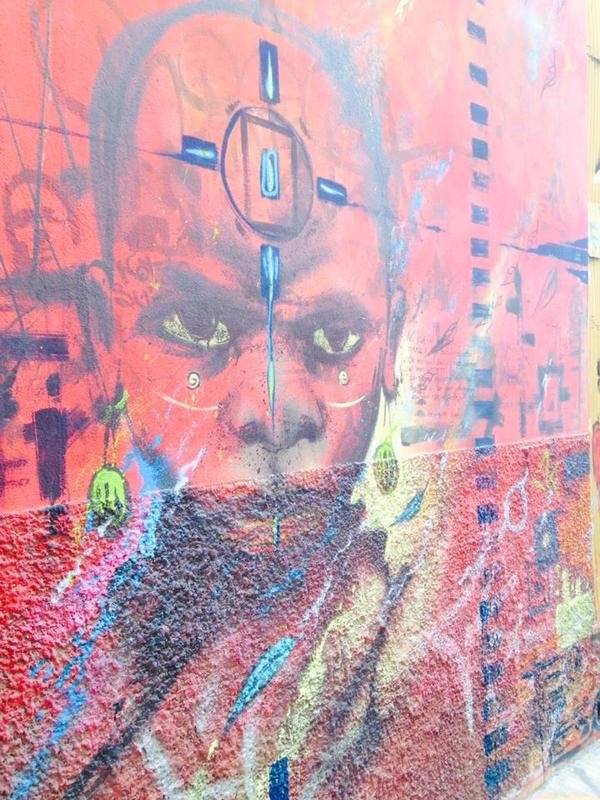
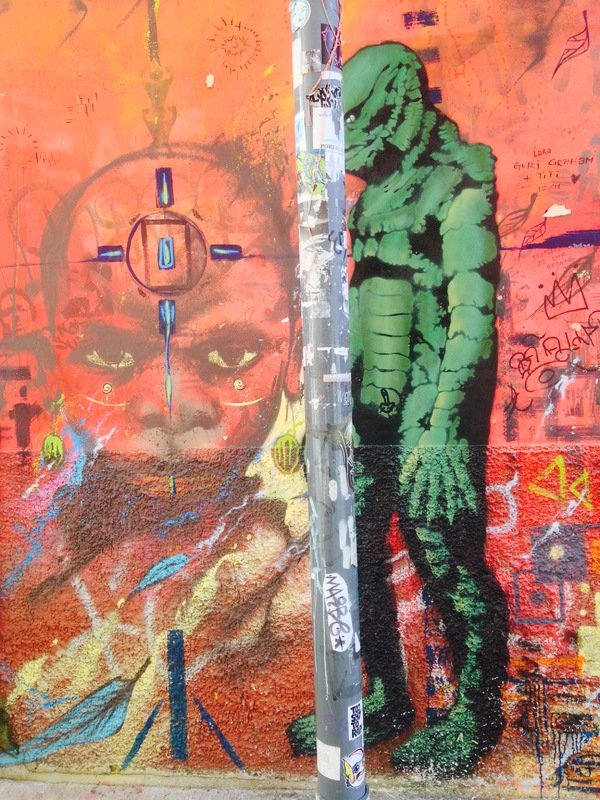
A Wall Dialogue
When I was in Valparaiso in 2014, this piece jumped out at me and became my favorite artwork of the city. I was infatuated with the face and the colors, and would take a detour to through the paseo of cerro concepcion just to see it whenever I was in the area. Returning to Valparaiso in 2016, I was excited to return to the piece. Imagine my surprise when I found that someone had drawn over part of the mural with what appears to be a teenage mutant ninja turtle. My initial reaction was anger that any one would deface such a beautiful painting. However, over time the green figure made me appreciate the fluidity and impermanence of graffiti.
Henri Lefebvre in The Urban Revolution said that “Society has been completely urbanized… The street is a place to play and learn. The street is disorder…This disorder is alive. It informs. It surprises… The urban space of the street is a place for talk, given over as much to the exchange of words and signs as it is to the exchange of things. A place where speech becomes writing. A place where speech can become 'savage' and, by escaping rules and institutions, inscribe itself on walls” (Irvine: 9). In this sense, public walls provide a space for artists to have a dialogue with one another. Part of this dialogue is painting over or next to someone else’s work. Graffiti shows that everything in life is in constant flux and cannot be controlled. It emphasizes the disorder of life and perhaps allows passerbyers to accept this chaos and let go of some internalized rules.
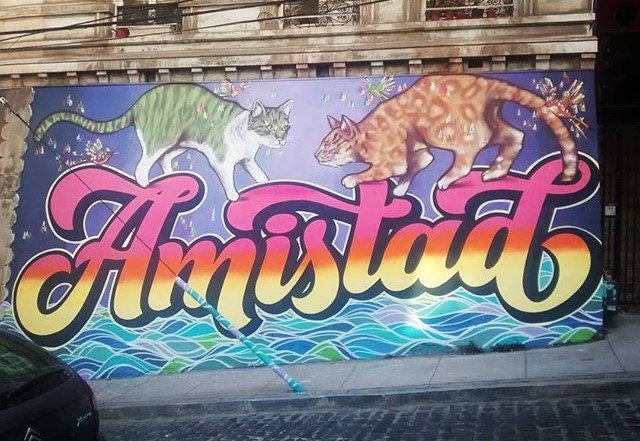
Amistad
This graffiti piece was created by artists Elliot Tupac of Peru and Charquipunk of Chile. The piece is a legal graffiti artwork and was commisioned by LAN airlines. Over the past decade graffiti has become recognized by the very multi-million dollar companies that the art form first sought to resist. Gleaton states that : “It is argued by some that this has negatively affected the art form as its depiction in the commercial sector presents a sterilized impression, divergent to what the art form in its rawest form is meant to represent. That being said, when the style is used for commercial means, it takes on a very different meaning. Instead of achieving some sort of social result or inspiring social change—forcing the viewer to think as any form of artwork would function, it “becomes a tool working in the service of another object” (113)” (Gleaton 2012: 52). The very roots of graffiti were to take back the public space that advertisers and governments wrongfully controlled. It became so successful that nowadays companies such as LAN have exploited the art-form for their own purposes. While it may not be directly advertising their company, their various commissioned graffiti pieces are shown in the magazine that most of their fliers read while aboard their planes.
Further, Charquipunk is an artist that is very well known in Valparaiso. His art pieces can be found all over the city, and many pieces include a hummingbird. Irvine speaks of the phenomenon that has occurred to many well known graffiti artist: “In the past fifteen years, many street artists have gone from underground, usually anonymous, hit and run, provocateurs pushing the boundaries of vandalism and toleration of private property trespass to highly recognized art stars invited to create legal, commissioned wall murals and museum installations” (Irvine: 6). Along with the exploitation and commercialization of graffiti from companies such as LAN, we are also seeing many artists working alongside such companies who once were working against them. This can be argued as a progress in the recognition of graffiti as an artform and a step up for these artists. However, if the very root of graffiti is to be able to express freely and without censorship the thoughts of an artist, then this root has faded. When Charquipunk is commissioned by a large company to create a certain piece, he does not have the same artistic freedom and raw feeling behind a piece as when he is simply creating for creating’s sake.
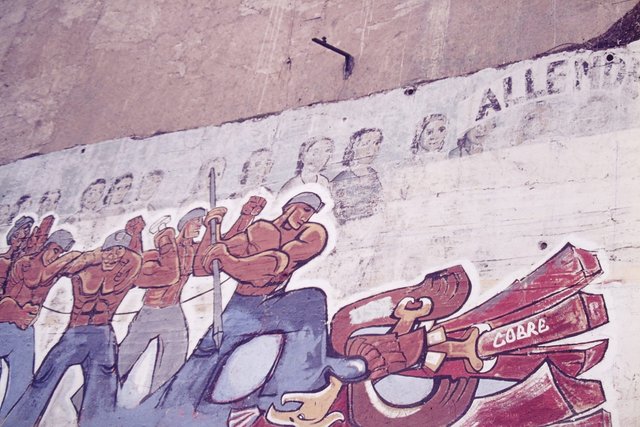
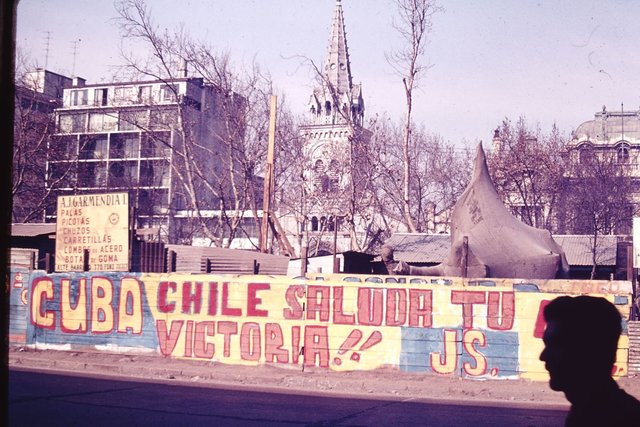
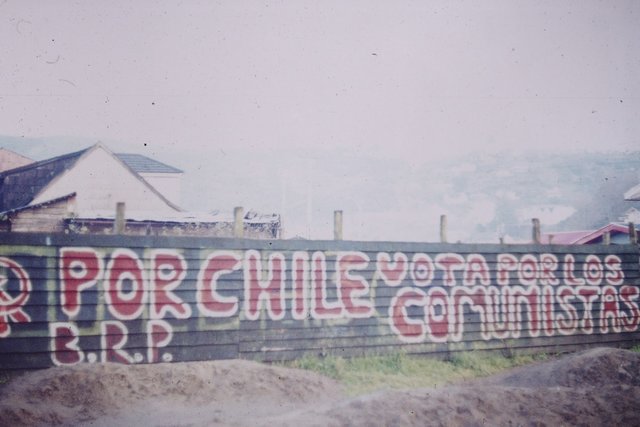
El Cobre es Chileno
These photos where taken by my father, Bill Baumeister, when he was traveling in Chile in 1970-1971. They are extremely political in nature and are all nationalistic as well as communistic. Gleaton speaks about such graffiti when writing: “Graffiti and street art that is developing outside of North America, offers a prime example of urban art that emerges as a response to major political and social crises and upheavals—specifically the movements taking place in Egypt and Brazil. The people of these nations have found street art to be an important tool for expression, in which their “ethnic and ethnic-linguistic identification and symbols” represent their strive for “political recognition and rights under [their] dominant cultures” (Chaffee 11)” (Gleaton 2012: 24). These murals represent the people of Chile making their voice heard on a political scale by utilizing public spaces. This could have been a response to the many years of dictatorship that took away the rights of free speech.
Irvine writes that: “In many ways, street art is a response to this concentrated infrastructure with its unequal distribution of resources, property, and visibility. Street art reflects globalization while resisting being absorbed into its convenient categories” (Irvine: 10). The mural of the men stomping down the eagle that holds copper is a representation of the movement to nationalize Chilean copper. The men are Chilean workers who are taking their copper back from the hands of the United States. It is reflective of a world of globalization, while at the same time resisting the results of such globalization.
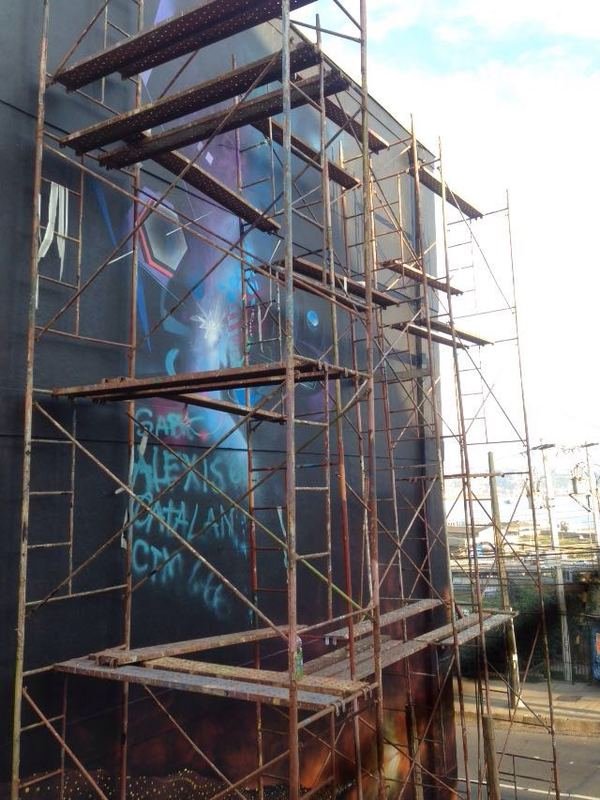
Tagging Over Murals
This mural was made for the project “Valparaiso en Colores”, meant to bring artwork to the less well-off cerro lecheros. However, the mural was anonymously tagged over during the night, destroying the work that was done. Irvine writes that: “Street art began as an underground, anarchic, in-your-face appropriation of public visual surfaces, and has now become a major part of visual space in many cities and a recognized art movement crossing over into the museum and gallery system” (Irvine: 1). This photo shows the potential faction between taggers and muralists. Every art movement evolves, and graffiti’s evolution now incorporates more commissioned artworks rather than illegal throw-ups. Many people were upset at the “vandalism” of the mural. However, if the basis of graffiti is to give everyone a voice and assert public space for all, then the tagger had the same right to that wall as the muralist. There is a danger in giving more validity to the sanctioned muralist than to the illegal tagger, because in doing so it un-democratizes the graffiti movement.
Gleaton argues that “Many graffiti writers were after recognition, by means of “spray-painting the most trains or the best pieces,” but it was the street artist that “wanted to communicate with the passerby or shape their environment without any constraints” (9)” (Gleaton 2012: 12). I disagree with this statement because it insinuates that tagging does not communicate with the public or shape the environment. It also does not recognize the social message behind the desire of recognition and of spraypainting one’s name on as many walls as possible. It also creates a divide between graffiti writers and street artists that does not always exist, for many street artists are also graffiti writers.

Decapitated Heads
This mural can be found in the flat land of Valparaiso that is less well off and generally has darker art pieces than other parts of the city. It depicts a woman of many heads holding in her two hands the decapitated head of a businessman and the decapitated head of an indigenous man. Gleaton writes that in graffiti pieces, “Rarely are the messages hard to decipher. Instead, street artists rely on simple, concise messages and a fusing of thoughts, ideas and commentary to initiate a political dialogue” (Gleaton 2012: 18). In this case, the mural does not rely on simple imagery to convey an obvious point. In fact, many pieces in Valparaiso are more abstract and multi-layered than Gleaton’s description of graffiti. There are many different ways ones could interpret this mural, and it does not offer one simple political dialogue.
This mural includes the head of an indigenous man, a theme that can be found in many artworks in Valparaiso (though usually the head is not decapitated). Many graffiti artists convey a theme of a pre-Columbian society through their works. If graffiti is a form of social commentary and a reflection of the current state of affairs, these artworks depict Chile’s desire to return to its pre-Columbian routes. Perhaps it reflects a search for a national identity that is outside of the identity sanctioned by the government and neo-liberal businesses.
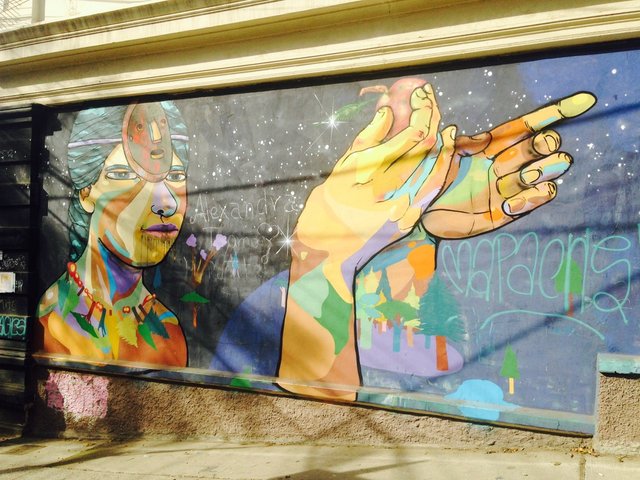
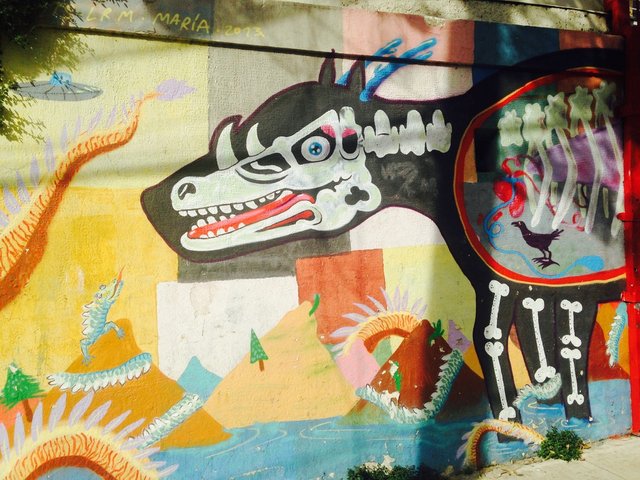
Graffiti Outside of My House
Both of these pieces are on the walls outside of my old house in Valparaiso, however I never took the time to look at them until writing this. I also lived here for two months in 2014 and barely recognized them when I returned this year. Ernest Abel and Barbara Buckle wrote: “Do we stop searching for the inner meaning of a painting or a poem when it appears on a wall merely because we do not happen to acknowledge the wall as a suitable receptacle for art or literature? Do we stop trying to understand what motivated the artist or the writer merely because he chose to express his thought through some unconventional medium? (14)” (Gleaton 2012: 47). I knew the murals of cerro alegre and concepcion better than the murals on my own home because I acknowledged the walls of those cerros as valid receptacles for art. I did not stop and search for meaning in these two murals because I did not recognize the validity of them due to their location. This is similar to the social experiment conducted in the DC metro station by famous violinist Joshua Bell. Joshua Bell is one of the best violinists in the United States, and in the 2007 he dressed like a normal street performer and played well-known works in the DC metro station to see how many people would notice him. Out of 1,070 passerbyers, only 27 people even acknowledged him. This is coming from a violinist who a week before had played at a sold out show at Boston’s Symphony Hall where tickets sold for about $100 per person. This proves Abel’s and Buckle’s point that people are only receptive to art when the art is presented in a socially acceptable manner.
Further, I may have glazed over these two murals due to an overload of visual sensory. As de Certeau observed, “from TV to newspapers, from advertising to all sorts of mercantile epiphanies, our society is characterized by a cancerous growth of vision, measuring everything by its ability to show or be shown and transmuting communication into a visual journey. It is a sort of epic of the eye and of the impulse to read. (65)” (Irvine: 21). While graffiti on the streets may liven up a city and bring new messages to its citizens, is it possible to have too much graffiti? Valparaiso is known for its endless graffiti, and many goods have come out of it. However, walking down the street can become overwhelming, and the visual overload can cause a shutdown in receptability of what the city has to offer. Just as pedestrians do not have a choice in consuming the big billboards and advertisements of businesses, they also do not have a choice in consuming the various graffiti pieces on their city walls.
The Beautiful City of Valparaiso
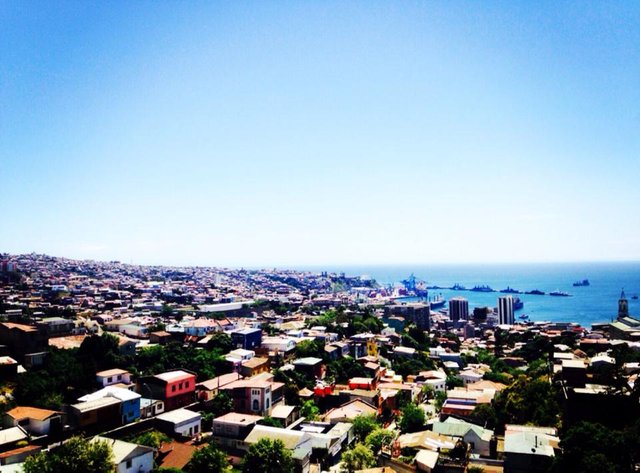
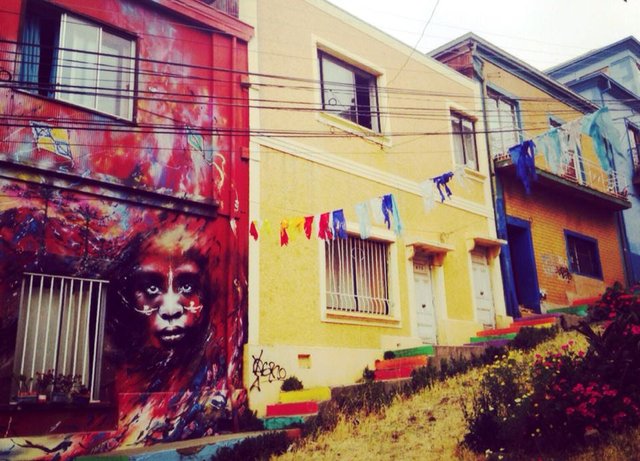
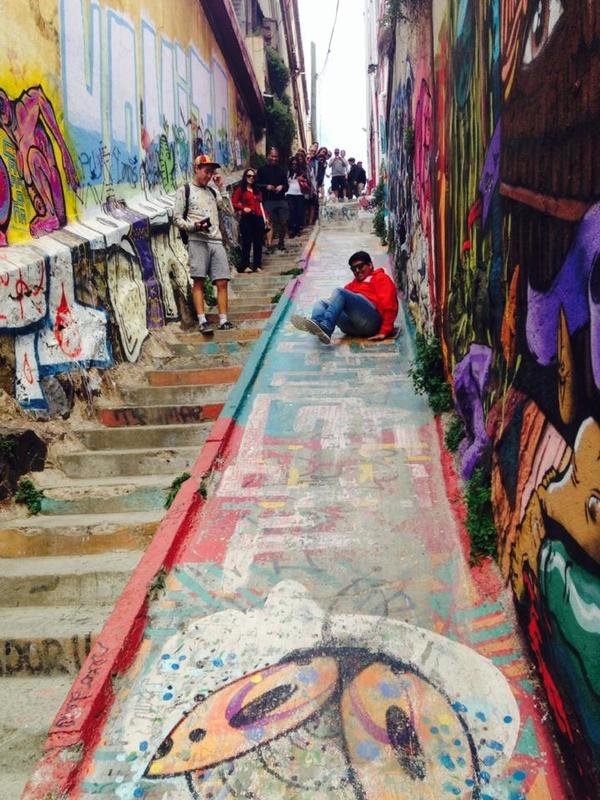
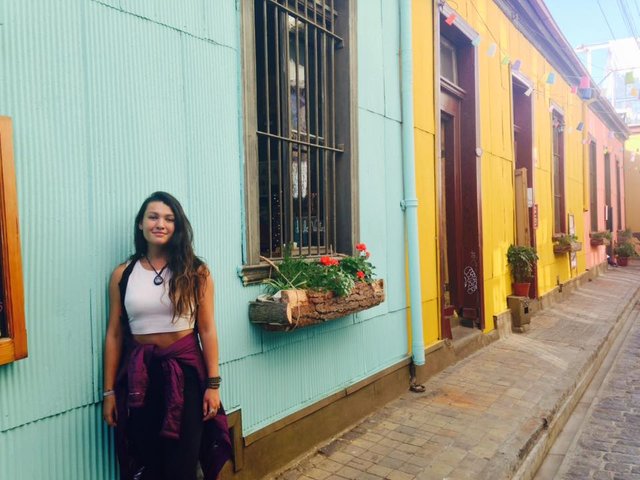
I like the graffiti outside the crib, nice theirs a lot of art en el Vaparaiso
Downvoting a post can decrease pending rewards and make it less visible. Common reasons:
Submit
Yeah Valparaiso has some crazy awesome art all over the walls and streets!
Downvoting a post can decrease pending rewards and make it less visible. Common reasons:
Submit
Great post @anwenbaumeister and thank you for giving us some love on our introduction! We have since released our first edition. We are seeking some feedback as to whether people perform one topic or many topics in a most! Would love to hear your thoughts? Following you now.
Downvoting a post can decrease pending rewards and make it less visible. Common reasons:
Submit
Thanks so much! I love your first edition. I'll write the same thing that I wrote in my reply to @clevecross:
Are you on Steem Chat by any chance? https://steemit.chat/
If so shoot me a direct message and I'd be happy to talk with you about your posts, answer any questions you may have, and offer feedback.
Downvoting a post can decrease pending rewards and make it less visible. Common reasons:
Submit
woow cool post
thank you @anwenbaumeister
Downvoting a post can decrease pending rewards and make it less visible. Common reasons:
Submit
Thank you I'm glad you liked it :-)
Downvoting a post can decrease pending rewards and make it less visible. Common reasons:
Submit
These are incredible pieces! I can't even imagine what it's like to create on a building or public place. I'm such a novice when it comes to art in that form that I certainly don't have the confidence to even think about showing it to anyone. I remember when I was younger, graffiti translated into "don't go down that street" But it's become a lot more mainstream and honestly, I think I'd rather see beautiful creations from the minds of our artists instead of abandoned buildings that look run down and ugly.
Downvoting a post can decrease pending rewards and make it less visible. Common reasons:
Submit
Some beautiful art there. Great post i love graffiti, i was lucky enough to have an artist graffiti a steemit logo , you can see it here if you are interested:) https://steemit.com/steemit/@cryptoiskey/the-first-steemit-graffiti-on-venice-beach-california-our-mission-to-spread-the-word-with-100-steem-cards-and-steemit-swag
Downvoting a post can decrease pending rewards and make it less visible. Common reasons:
Submit
Thanks! I saw your post when you first put it up and upvoted it, awesome work! Venice Beach is such a fun place to spread awareness about Steemit.
Also if you're in the mood for a road trip up north @steemrollin and I are planning the Bay Area's first Steemit Meetup :-) https://www.meetup.com/steemitsf/
Downvoting a post can decrease pending rewards and make it less visible. Common reasons:
Submit
oh wow ,another 3 weeks yeah?..25th August in San Francisco?...I would love to make that, I will try my best, depends on if I can get someone to look after my boy...but I will definitely try:)
Downvoting a post can decrease pending rewards and make it less visible. Common reasons:
Submit
Awesome!
Downvoting a post can decrease pending rewards and make it less visible. Common reasons:
Submit
👍amazing graffiti @anwenbaumeister
Downvoting a post can decrease pending rewards and make it less visible. Common reasons:
Submit
Wow. You have captured some outstanding artwork there. It is frankly not the kind of thing I would really expect to see or associate with Chile. Thanks for sharing your experiences and such vibrant creativity. I am just blown away by the talent and skill of some of these street artists.
I think it just goes to show how much potential and ability (often much of it untapped or under appreciated) around us.
I am often pleasantly surprised by the street art I see even in my own hometown. It has really taken off as an art form due to the likes of people like Banksy.
Downvoting a post can decrease pending rewards and make it less visible. Common reasons:
Submit
Beautiful pictures and I very much enjoy your writing style. I am not intending or trying to spam your post. I am struggling a bit with grabbing attention for my posts or any real feedback on what may be lacking. If you could take a moment to look for me? Your help and not your upvote is all I am asking.
Hey Science, It's me Religion. Sorry?
Downvoting a post can decrease pending rewards and make it less visible. Common reasons:
Submit
Thanks so much! Are you on Steem Chat by any chance? https://steemit.chat/
If so shoot me a direct message and I'd be happy to talk with you on how to grab attention on your posts and offer feedback.
Downvoting a post can decrease pending rewards and make it less visible. Common reasons:
Submit
I am... off to work but I will be very happy to pick your brain when I am back and you are on. Very much appreciated
Downvoting a post can decrease pending rewards and make it less visible. Common reasons:
Submit
Beautiful art!
Downvoting a post can decrease pending rewards and make it less visible. Common reasons:
Submit
Beautiful!
Downvoting a post can decrease pending rewards and make it less visible. Common reasons:
Submit
I'm really happy you had such a great experience here! Last week I posted something about my Valparaiso trip (https://steemit.com/travel/@budgetbucketlist/the-less-glamorous-side-of-traveling-how-i-escaped-an-armed-gang-rape), which was quite the opposite. However, good and bad things are usually not related to place, although non-travelers sometimes like to think that... Especially places that are not theirs and easy to judge. I'll use your article as a reference for everyone as an opposition of mine ;) I'm still in love with Chile
Downvoting a post can decrease pending rewards and make it less visible. Common reasons:
Submit
Very cool. The story, and especially the art. :-)
Downvoting a post can decrease pending rewards and make it less visible. Common reasons:
Submit
"take back the public space that advertisers and governments wrongfully controlled"
Downvoting a post can decrease pending rewards and make it less visible. Common reasons:
Submit